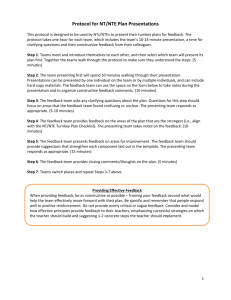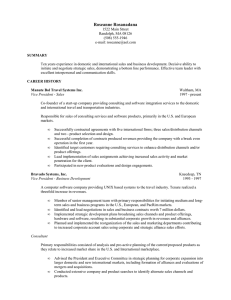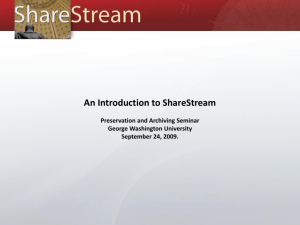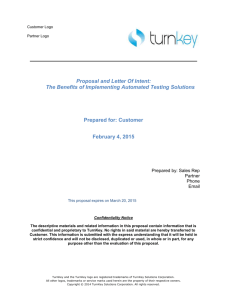M E odular- : A Logic for Assimilating Unexpected
advertisement
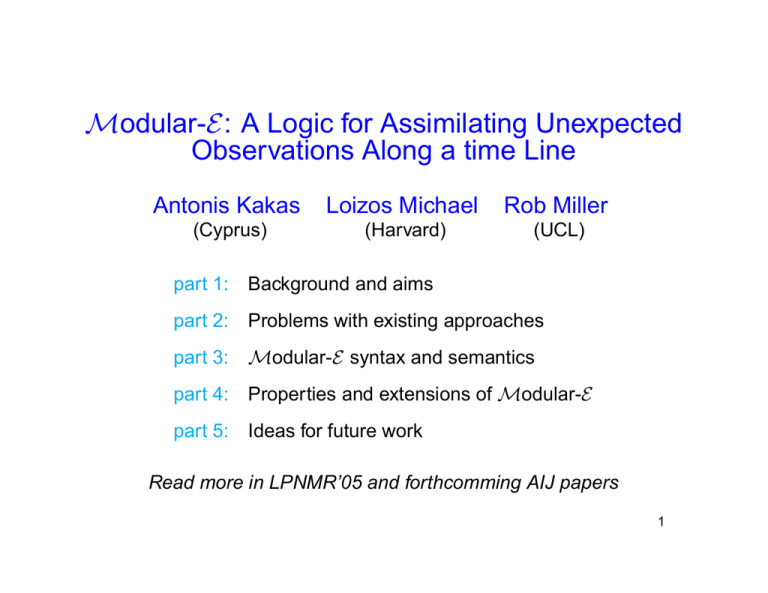
Modular-E: A Logic for Assimilating Unexpected
Observations Along a time Line
Antonis Kakas
Loizos Michael
Rob Miller
(Cyprus)
(Harvard)
(UCL)
part 1:
Background and aims
part 2:
Problems with existing approaches
part 3:
Modular-E syntax and semantics
part 4:
Properties and extensions of Modular-E
part 5:
Ideas for future work
Read more in LPNMR’05 and forthcomming AIJ papers
1
Historical Context
The idea of using symbolic logic to model human reasoning goes back a
long way ...
• Before A.I. - Aristotle, Chrysippus, Descartes, Leibniz (a librarian!), de
Morgan, Frege, Boole, Venn, Russell, Tarski, Gödel, ...
• A.I. - John McCarthy
– “Programs with Common Sense” (1959).
– Concepts such as “cause”, “effect” and “action” are essential for
key human reasoning processes such as planning.
– In 1969 McCarthy and Hayes invent the Situation Calculus.
– Broadens out into the A.I. sub-field of Reasoning about Action.
2
Modeling Cause and Effect in Logic
• Example Applications:
– Automated planning - underpins much contemporary research.
– Causal Modeling - e.g. simulation of complex biological systems.
– Software Specification - e.g. of “event-driven” systems.
• Issues and Problems:
– The Frame Problem - reasoning about non-effects of actions.
– The Ramification Problem - reasoning about indirect effects.
– The Qualification Problem - reasoning about unexpected effects.
3
Event Calculus, Language E and Modular-E
• Logic-based, model-theoretic formalisms for reasoning about action.
• Event Calculus first proposed by Bob Kowalski and Marek Sergot as a
logic program, and later re-cast in classical logic.
• Language E and Modular-E (ME ) are specialised “action description” logics developed from the Event Calculus, with a restricted highlevel syntax.
• All similar in some respects to the Situation Calculus but with a different ontological basis, with:
–
–
–
–
fluents (properties that are true or false at different times),
actions,
time-points (arranged in a line), and
events (for a narrative of action “happenings” at particular times).
4
Representing Time
• Situation Calculus - branching, constructed from hypothetical actions:
Sneeze(S0)
S0
CheckGear(S0)
TurnKey(S0)
Sneeze(Sneeze(S0))
CheckGear(Sneeze(S0))
TurnKey(Sneeze(S0))
Sneeze(CheckGear(S0))
CheckGear(CheckGear(S0))
TurnKey(CheckGear(S0))
Sneeze(TurnKey(S0))
CheckGear(TurnKey(S0))
TurnKey(TurnKey(S0))
.....
• Event Calculus, E and ME - linear, events embedded within it:
0
1
Sneeze
2
CheckGear
3
4
TurnKey
5
An Example Modular-E Theory
• {TurnKey, Petrol, BatteryCharged} causes EngineRunning
{EngineRunning, ¬Oil} causes EngineTooHot
EngineTooHot causes Smoke
(Petrol ∧ BatteryCharged ∧ ¬EngineRunning) holds-at 2
(¬EngineTooHot ∧ ¬Smoke) holds-at 3
TurnKey occurs-at 5
• Two models, because we don’t know about Oil.
• Solution to the Ramification Problem ensures that if there’s no oil,
there’s smoke e.g. at time 6.
6
Models of A Modular-E Theory
{TurnKey, Petrol, BatteryCharged} causes EngineRunning
{EngineRunning, ¬Oil} causes EngineTooHot
EngineTooHot causes Smoke
(Petrol ∧ BatteryCharged ∧ ¬EngineRunning) holds-at 2
(¬EngineTooHot ∧ ¬Smoke) holds-at 3
TurnKey occurs-at 5
Petrol
¬EngineRunning
¬EngineTooHot
¬Smoke
BatteryCharged
¬Oil
Petrol
¬EngineRunning
¬EngineTooHot
¬Smoke
BatteryCharged
¬Oil
Petrol
¬EngineRunning
¬EngineTooHot
¬Smoke
BatteryCharged
¬Oil
Petrol
¬EngineRunning
¬EngineTooHot
¬Smoke
BatteryCharged
¬Oil
2
3
4
TurnKey
6
Petrol
¬EngineRunning
¬EngineTooHot
¬Smoke
BatteryCharged
Oil
Petrol
¬EngineRunning
¬EngineTooHot
¬Smoke
BatteryCharged
Oil
Petrol
¬EngineRunning
¬EngineTooHot
¬Smoke
BatteryCharged
Oil
Petrol
¬EngineRunning
¬EngineTooHot
¬Smoke
BatteryCharged
Oil
Petrol
EngineRunning
¬EngineTooHot
¬Smoke
BatteryCharged
Oil
2
3
4
TurnKey
Petrol
EngineRunning
EngineTooHot
Smoke
BatteryCharged
¬Oil
6
7
The Qualification Problem
“In order to fully represent the conditions for the successful
performance of an action, an impractical and implausible number of qualifications would have to be included in the sentences expressing them.”
– John McCarthy, 1980
{TurnKey, Petrol, BatteryCharged, ¬PotatoInExhaustPipe, ......}
causes EngineRunning
8
Aims of This Study
To to look at aspects of the qualification problem in the context of reasoning
about narratives of action occurrences and observations:
• “Exogenous problem” – how to recover from unexpected observations:
TurnKey causes Running
TurnKey occurs-at 1
¬Running holds-at 2 ( ! )
• “Endogenous problem” – how to add qualifications, constraints and
other effect laws in a modular and elaboration tolerant way:
either Broken prevents Running (from being caused)
or always ¬(Broken ∧ Running) (at this temporal granularity)
or Broken causes ¬Running (a competing indirect effect law)
( perhaps together with normally ¬Broken )
9
Original Strategy and Some Problems
We wanted to
• Introduce extra (default) reasoning mechanisms into the Language E,
in particular adapting some of Thielscher’s AIJ ideas.
But ...
• Language E’s solutions to the frame and ramification problems are not
robust or complete enough for this.
• Other formalisms have similar or related deficiencies for our purposes.
So ...
• We developed Modular-E (ME), with the “free will” property necessary for our default reasoning approach to the qualification problem.
10
Unexpected Observations: Two Light Bulbs
Example
• PressDownSwitch has action precondition ¬SwitchStuck
• PressDownSwitch causes LightA if ¬FaultyBulbA (i.e. ¬FaultyBulbA is
a fluent precondition). Similarly for LightB.
• Normally (i.e. by default) ¬SwitchStuck, ¬FaultyBulbA, ¬FaultyBulbB.
• PressDownSwitch is executed, but afterwards ¬LightA is observed.
• We would like to conclude (FaultyBulbA ∨ SwitchStuck).
(Thielscher: solve “weak” and “strong” qualification problems.)
11
Fluent / Situation Calculus Style Solution?
Poss(PressDownSwitch, s) ≡ ¬Holds(Ab(SwitchStuck), s).
Poss(PressDownSwitch, s) →
[Holds(f, Do(PressDownSwitch, s)) ≡
(Holds(f, s) ∨
(f = LightA ∧ ¬Holds(Ab(FaultyBulbA), s)) ∨ ... etc.
)].
¬Holds(LightA, Do(PressDownSwitch, S0)).
• Frame problem: given Holds(CupOnTable, S0), we can’t conclude
Holds(CupOnTable, Do(PressDownSwitch, S0)).
12
Modular-E
• Regards action execution statements as “attempts” to perform actions,
which fail (have no effect) if action preconditions are not met.
• Solution to frame problem covers both failed and successful actions.
• Solution to ramification problem covers concurrent actions, non-determinism
and looping indirect effects (oscillations). Resolves conflicting effects
by non-determinism, taking “race conditions” into account.
• Highly modular and elaboration tolerant. Effect laws can “pick up” extra qualifications from other propositions (“global qualifications”). Any
effect law can be consistently added to any consistent theory.
• Enjoys a “free will” property – any action can be attempted in any circumstance (without constraining the past).
• Separates task of qualifying effect laws into “endogenous” and “exogenous” problems, with the latter solvable by simple minimization.
13
Modular-E Syntax
h-propositions of the form:
o-propositions of the form:
c-propositions of the form:
p-propositions of the form:
a-propositions of the form:
n-propositions of the form:
φ holds-at T
A occurs-at T
C causes L
φ prevents E
always φ
normally L
(φ = fluent formula, L = fluent literal, C = set of fluent and action literals,
E = set of action constants and fluent literals.)
C causes L
–
“C provisionally causes L” (qualified both locally by
C and globally via other c-, p- and a-props).
φ prevents E
–
“φ prevents the actions and fluents in E from
being executed/caused simultaneously.”
always φ
–
“¬φ is unobservable.”
14
Two Light Bulbs Example in ME
SwitchStuck prevents PressDownSwitch
PressDownSwitch causes ElectricCurrent
{ElectricCurrent, ¬FaultyBulbA} causes LightA
{ElectricCurrent, ¬FaultyBulbB} causes LightB
always (¬ElectricCurrent → (¬LightA ∧ ¬LightB))
normally ¬SwitchStuck
normally ¬FaultyBulbA
normally ¬FaultyBulbB
PressDownSwitch occurs-at 1
¬LightA holds-at 2
15
Modular-E Semantics
• Interpretations are mappings from fluent/timepoint pairs to {true, false}.
• Models are interpretations in which every fluent literal persists until its
converse appears in a timepoint’s change set.
• Change sets are computed by identifying proper causal descendants
within causal chains.
• In a causal chain, causal laws trigger (instantaneous) processes, which
are then resolved further along the chain.
h{¬Running}, {TurnKey}, ∅i → h{¬Running}, {TurnKey}, {↑Running}i → h{Running}, ∅, ∅i
16
The Role of P-propositions
P-propositions prevent c-propositions from triggering processes within causal
chains:
TurnKey causes Running
TurnKey occurs-at 1
Broken prevents Running
h{Broken, ¬Running}, {TurnKey}, ∅i
↓
h{Broken, ¬Running}, {TurnKey}, ∅i
↓
h{Broken, ¬Running}, ∅, ∅i
17
The Role of A-propositions
A-propositions provide (“global”) qualifications to effect laws by constraining the selection of proper causal descendants within causal chains:
TurnKey causes Running
TurnKey occurs-at 1
always ¬(Broken ∧ Running)
h{Broken, ¬Running}, {TurnKey}, ∅i
↓
h{Broken, ¬Running}, {TurnKey}, {↑Running}i
↓
h{Broken, Running}, ∅, ∅i
18
Interaction Between C-propositions
Conflicting c-propositions result in conflicting processes, which resolve nondeterministically:
TurnKey causes Running
TurnKey occurs-at 1
Broken causes ¬Running
h{Broken, ¬Running}, {TurnKey}, ∅i
↓
h{Broken, ¬Running}, {TurnKey}, {↑Running, ↓Running}i
.
&
h{Broken, ¬Running}, ∅, ∅i
h{Broken, Running}, ∅, ∅i
↓
h{Broken, Running}, ∅, {↓Running}i
↓
h{Broken, ¬Running}, ∅, ∅i
19
Modularity, Elaboration Tolerance and Free Will Results
• Free Will Theorem: Let M be a model of a finite domain description
D that doesn’t include observations after timepoint T . Then for any
action A there is a model of D ∪ {A occurs-at T } identical to M up
until T .
• Causal Elaboration Tolerance Theorem: Let Da be a consistent
collection of a-propositions and let E be a finite set of o-, c- and ppropositions. Then Da ∪ E is consistent.
• In Modular-E, given a consistent initial situation, inconsistency arises
only when observations conflict with predictions (generated from
earlier observations together with causal laws).
• Allows a clean separation of “endogenous” and “exogenous” qualification problems – the latter now solvable by simple minimization.
20
ME’s Approach to Exogenous Qualification
• Transform domain D into the default domain description Dd:
– “C causes L” becomes “C ∪ {NormExo(unique-id)} causes L”
– for each action A add “¬NormExo(A) prevents A”
– add “ normally NormExo(...)” for each NormExo(...)
• Default models of D are defined as maximal (w.r.t. NormExo fluents)
models of Dd.
• If there are no observations after an initial time-point, this transformation has no effect.
21
Exogenous “Failures” Example
TurnKey causes Running
TurnKey occurs-at 1
¬Running holds-at 2
¬Running
¬Running
0
TurnKey
• Replace (1) by:
and add:
(1)
(2)
(3)
¬Running
¬Running
2
3
Running ?
Running ?
{NormExo(1), TurnKey} causes Running
normally NormExo(1)
NormExo(1) NormExo(1) NormExo(1) NormExo(1)
¬Running
¬Running
Running
Running
0
2
3
TurnKey
¬NormExo(1) ¬NormExo(1) ¬NormExo(1) ¬NormExo(1)
¬Running
¬Running
¬Running
¬Running
0
2
3
TurnKey
22
Exogenous “Failures” & Exogenous “Accidents”
TurnKey causes Running
TurnKey occurs-at {1, 3}
¬Running holds-at 2
(1)
(2)
(3)
• Failures only: “¬Running holds-at 4” given by replacing (1) by:
{NormExo(1), TurnKey} causes Running
normally NormExo(1)
• Accidents only: “Running holds-at 4” given by replacing (1) by:
{¬AbnormExoAction(1), TurnKey} causes Running
• Recovery policies can mix and match as required.
23
Conclusions
• Narrative-based formalisms, with explicit notions of “observation”
and “action occurrence”, are preferable for specifying (aspects of)
the qualification problem.
• Modular and elaboration tolerant frameworks with characteristics such
as the “free will” property facilitate clean solutions to the qualification
problem, and help disambiguate its various aspects.
• Complete and elaboration tolerant solutions to the ramification and
“endogenous” qualification problems enable the “exogenous” qualification problem to be tackled using straightforward minimization.
• The notion of (micro) processes is useful to avoid over-constraining
models in domains involving concurrency, non-determinism, oscillations
and/or “race conditions” between competing effects.
24
Ideas for Future Work
• Study “recovery policies” and how to succinctly specify them.
• Improve the implemention of (a useful fragment of) Modular-E. (Show
soundness/completeness?)
• Look at the computational qualification problem (how can reasoning
disregard “abnormal” conditions unless there is evidence for them?).
• Study further the differences between various types of causal and noncausal relationships that might hold between fluents (relationships at
different temporal granularities, “definitional” relationships, etc.).
• Export some of Modular-E’s notions to classical formalisms such as
the Event Calculus.
• Do some empirical testing to see the extent to which Modular-E corresponds to common sense.
• Applications: Computational biology? Modular-E in control modules?
25
Extra Slides ...
26
Faulty Circuit Example
SwitchOn causes ElectricCurrent
ElectricCurrent causes BrokenFuse
BrokenFuse causes ¬ElectricCurrent
always ¬(ElectricCurrent ∧ BrokenFuse)
h{¬ElectricCurrent, ¬BrokenFuse}, {SwitchOn}, ∅i
↓
h{¬ElectricCurrent, ¬BrokenFuse}, {SwitchOn}, {↑ElectricCurrent}i
↓
h{ElectricCurrent, ¬BrokenFuse}, ∅, ∅i
↓
h{ElectricCurrent, ¬BrokenFuse}, ∅, {↑BrokenFuse}i,
↓
h{ElectricCurrent, BrokenFuse}, ∅, ∅i
↓
h{ElectricCurrent, BrokenFuse}, ∅, {↓ElectricCurrent}i
↓
h{¬ElectricCurrent, BrokenFuse}, ∅, ∅i
27
Non-deterministic Lift Door Example
{PressOpen} causes DoorOpen
{PressClose} causes ¬DoorOpen
DoorOpen holds-at 1
PressOpen occurs-at 2
PressClose occurs-at 2
h{DoorOpen}, {PressClose, PressOpen}, ∅i
↓
h{DoorOpen}, {PressClose, PressOpen}, {↑DoorOpen, ↓DoorOpen}i
.
&
h{DoorOpen}, ∅, ∅i
h{¬DoorOpen}, ∅, ∅i
28
An Oscillator
{On} causes ¬On
{¬On} causes On
h{On}, ∅, ∅i
↓
h{On}, ∅, {↓On}i
↓
h{¬On}, ∅, ∅i
↓
h{¬On}, ∅, {↑On}i
↓
h{On}, ∅, ∅i
h{¬On}, ∅, ∅i
↓
h{¬On}, ∅, {↑On}i
↓
h{On}, ∅, ∅i
↓
h{On}, ∅, {↓On}i
↓
h{¬On}, ∅, ∅i
29
Broken Car Example C
TurnKey causes Running
always ¬(Broken ∧ Running)
TurnKey occurs-at 1
Break causes Broken
Broken causes ¬Running
Break occurs-at 1
h{¬Br , ¬Ru}, {TurnKey, Break}, ∅i
↓
h{¬Br , ¬Ru}, {TurnKey, Break }, {↑Ru, ↑Br }i
.
↓
&
h{Br , ¬Ru}, ∅, {↑Ru}i
h{Br , Ru}, ∅, ∅i
h{¬Br , Ru}, ∅, {↑Br }i
↓
↓
↓
h{Br , ¬Ru}, ∅, {↑Ru, ↓Ru}i
h{Br , Ru}, ∅, {↓Ru}i
h{¬Br , Ru}, ∅, {↑Br }i
.
&
↓
↓
h{Br , ¬Ru}, ∅, ∅i
h{Br , Ru}, ∅, ∅i
h{Br , ¬Ru}, ∅, ∅i
h{Br , Ru}, ∅, ∅i
↓
↓
h{Br , Ru}, ∅, {↓Ru}i
h{Br , Ru}, ∅, {↓Ru}i
↓
↓
h{Br , ¬Ru}, ∅, ∅i
h{Br , ¬Ru}, ∅, ∅i
30
Broken Car Example D, with “Race Conditions”
When the car is left in anti-theft mode (ATM), running the engine (even for
an instant) will trigger the alarm:
TurnKey causes Running
always ¬(Broken ∧ Running)
{Running, ATM} causes Alarm
Break causes Broken
Broken causes ¬Running
{Break, TurnKey} occurs-at 1
h{¬Br , ¬Ru, ¬Al, ATM}, {TurnKey, Break}, ∅i
↓
h{¬Br , ¬Ru, ¬Al, ATM}, {TurnKey, Break }, {↑Ru, ↑Br }i
.
↓
&
h{Br , ¬Ru, ¬Al, ATM}, ∅, {↑Ru}i
etc.
h{Br , Ru, ¬Al, ATM}, ∅, ∅i
.
..
↓
↓
h{Br , ¬Ru, ¬Al, ATM}, ∅, {↑Ru, ↓Ru}i
h{Br , Ru, ¬Al, ATM}, ∅, {↓Ru, ↑Al}i
.
&
.
↓
&
h{Br , ¬Ru, Al, ATM}, ∅, ∅i
etc.
etc.
etc.
h{Br , ¬Ru, ¬Al, ATM}, ∅, ∅i
...
...
...
31
Promotion Example
An employee gets promoted at time 1. Promotion results in a large office
(LO) and big salary (BS). But nobody gets a large office when the building
is overcrowded (OC), which it is at time 1:
Promote causes {BS, LO}
always ¬(OC ∧ LO)
(¬LO ∧ ¬BS ∧ OC) holds-at 1
Promote occurs-at 1
h{¬LO, ¬BS, OC}, {Promote}, ∅i
↓
h{¬LO, ¬BS, OC}, {Promote}, {↑LO, ↑BS}i
.
↓
&
h{LO, ¬BS, OC}, ∅, {↑BS}i
h{LO, BS, OC}, ∅, ∅i
h{¬LO, BS, OC}, ∅, {↑LO}i
↓
↓
h{LO, ¬BS, OC}, ∅, {↑BS}i
h{¬LO, BS, OC}, ∅, {↑LO}i
↓
↓
h{LO, BS, OC}, ∅, ∅i
h{LO, BS, OC}, ∅, ∅i
32
Definition of Triggering
Let D be a domain description, N = hS, B, P i a node, Lt a set of fluent
literals, Pt = {proc(L) | L ∈ Lt}, and Bt a set of action constants. The
set (Bt ∪ Pt) is triggered at N with respect to D iff
1. Bt ⊆ B
2. For each p-proposition “φ prevents E” in D, either φ is not satisfied
in S or E 6⊆ (Bt ∪ Lt).
3. For each L ∈ Lt there is a c-proposition “C causes L” in D such that
(i) for each action constant A ∈ C, A ∈ Bt, (ii) for each action literal
¬A ∈ C, A 6∈ Bt, and (iii) for each fluent literal L0 ∈ C, L0 ∈ S.
(Bt ∪ Pt) is maximally triggered at N with respect to D iff there is no
other set (Bt0 ∪ Pt0) also triggered at N with respect to D and (Bt ∪ Pt) is
a strict subset of (Bt0 ∪ Pt0).
33
Stationary And Static Nodes
Let D be a domain description and N = hS, B, P i a causal node. N is
stationary iff for each resolvant hS 0, ∅, P 0i of N , S 0 = S. N is static w.r.t.
D iff every process successor of N w.r.t. D is stationary.
34
Causal Chain Definition
Let D be a domain description and let N0 be a node. A causal chain
rooted at N0 with respect to D is a (finite) sequence N0, N1, ..., N2n of
nodes such that for each k, 0 ≤ k ≤ n − 1, N2k+1 is a process successor
of N2k w.r.t. D and N2k+2 is a resolvant of N2k+1, and such that the
following conditions hold:
1. N2n is fully resolved.
2. N2n is static, or there exists k < n s.t. N2n = N2k .
3. If there exists j < k ≤ n s.t. N2j = N2k then k = n.
4. There does not exist a k < n s.t. N2k is static.
35
Proper Causal Descendant Definition
Let D be a domain description and let N0 and N be nodes. N is a proper
causal descendant of N0 w.r.t. D iff N is a-consistent w.r.t. D, and there
exists a causal chain N0, N1, ..., N2n w.r.t. D such that N = N2k for some
0 ≤ k ≤ n and at least one of the following two conditions holds:
1. There exists j ≤ k such that N2j = N2n.
0
0
2. There does not exist a causal chain N0, N1, ..., N2k , N2k+1
, ..., N2m
0 is a-consistent w.r.t. D.
w.r.t. D and a j such that k < j ≤ m and N2j
A state S is stable w.r.t. D if there exists a node hS, ∅, P i which is a proper
causal descendant of hS, ∅, ∅i.
36
Definition of a Model
Let D be a domain description, and let Φ∗ be the set of all (+ve and -ve)
fluent literals in the language. Then an interpretation H is a model of D iff
∗
there exists a mapping c : Π 7→ 2Φ such that for all T , c(T ) is a change
set at T w.r.t. H, and the following three conditions hold. For every fluent
literal L and time-points T1 ≺ T3:
1. If H satisfies L at T1, and there is no time-point T2 s.t. T1 T2 ≺ T3
and L ∈ c(T2), then H satisfies L at T3.
2. If L ∈ c(T1), and there is no time-point T2 such that T1 ≺ T2 ≺ T3
and L ∈ c(T2), then H satisfies L at T3.
3. H satisfies the following constraints:
• For all “φ holds-at T ” in D, H satisfies φ at T .
• For all time-points T , S(H, T ) is a stable state.
37
Abductive and Deductive Planning
In the Event Calculus
“Happens(TurnKey, 1)” is a plan for “Holds(HasKey , 2)”
can be expressed abductively as:
THEORY ∧ [Happens(a, t) ≡ (a = TurnKey ∧ t = 1)] |= Holds(HasKey, 2)
or deductively as:
THEORY
|= [Happens(a, t) ≡ (a = TurnKey ∧ t = 1)] → Holds(HasKey , 2)
In general, the Deduction Theorem ensures that:
(THEORY ∧ PLAN) |= GOAL
iff
THEORY |= (PLAN → GOAL)
38
Anomalous Plans: Event Calculus Example
• Domain description: ∀t[Poss(TurnKey, t) ≡ Holds(HasKey, t)]
• EC general axioms including: ∀a, t[¬Poss(a, t) → ¬Happens(a, t)]
• EC Abductive Planning: Find PLAN s.t. (THEORY ∧ PLAN) |= GOAL
• (Completion of) “Happens(TurnKey, 1)” is a plan for “Holds(HasKey, 2)”!
(And worse - it’s a plan for “Holds(HasKey, 0)”.)
• Suspect similar problems for any formalism (e.g. TAL, Language C)
that represents action preconditions via narrative constraints, e.g:
⊥ ⇐ i : (PushBox(l) ∧ Loc(Monkey) 6= Loc(Box))
39
Anomalous Plans: Language E Example
TurnKey initiates Running
¬Running whenever {Broken}
3 models:
(a)
(b)
(c)
∀t : hRunning, ¬Brokeni
∀t : h¬Running, ¬Brokeni
∀t : h¬Running, Brokeni
Addition of “TurnKey happens-at 1” gives instead 2 models:
(a)
(b0)
∀t : hRunning, ¬Brokeni
∀t ≤ 1 : h¬Running, ¬Brokeni
∀t > 1 : hRunning, ¬Brokeni
so is a plan for “¬Broken holds-at 2”.
40
Anomalous Plans: Language E Example 2
PressDownSwitch initiates SwitchConnected when {¬SwitchStuck}
¬Light whenever {¬SwitchConnected}
¬Light whenever {SwitchConnected, Light}
Light whenever {SwitchConnected, ¬Light}
2 models:
(a) ∀t : h¬SwitchStuck, ¬SwitchConnected, ¬Lighti
(b) ∀t : hSwitchStuck, ¬SwitchConnected, ¬Lighti
Addition of “PressDownSwitch happens-at 1” eliminates model (a), so
is a plan for “SwitchStuck holds-at 2”.
41
Extra/Modified Frame Axioms?
• For the Situation Calculus:
¬Poss(a, s) → [Holds(f, Do(a, s)) ≡ Holds(f, s)]
• For the Event Calculus:
HoldsAt(f, t2) ← [HoldsAt(f, t1) ∧ t1 < t2 ∧ ¬Clipped(t1, f, t2)]
Clipped(t1, f, t2) ≡ ∃a, t[Happens(a, t) ∧ t1 ≤ t < t2 ∧
Poss(a, t) ∧ Terminates(a, f, t)]
HoldsAt(f, t2) ← [Happens(a, t1) ∧ Initiates(a, f, t1) ∧
Poss(a, t1) ∧ t1 < t2 ∧ ¬Clipped(t1, f, t2)]
42
Some References
• A. Kakas, L. Michael and R. Miller. Modular-E: an Elaboration Tolerant
Approach to the Ramification and Qualification Problems. Proceedings of LPNMR 2005. (Journal version to appear in AIJ.)
• R. Miller and M. Shanahan. Some Alternative Versions of the Event
Calculus. Lecture Notes in Artificial Intelligence, vol. 2408, 2002.
• R. Miller. Three Problems in Logic-based Knowledge Representation.
ASLIB Proceedings: New Information Perspectives, vol. 58, 2006.
• M. Thielscher. The Qualification Problem: A Solution to the Problem
of Anomalous Models. AIJ, 131(1-2):1-37, 2001.
• A. Herzig and I. Varzinczak. Domain Descriptions Should be Modular.
Proceedings of ECAI 2004.
43
Some Existing Applications of the Event Calculus
• planning
• cognitive robotics
• abductive reasoning
• database updates
• accident report processing
• legal reasoning
• modelling continuous change and mathematical modelling
• modelling and reasoning about agent beliefs
• reasoning about programming constructs
• and software engineering
44

